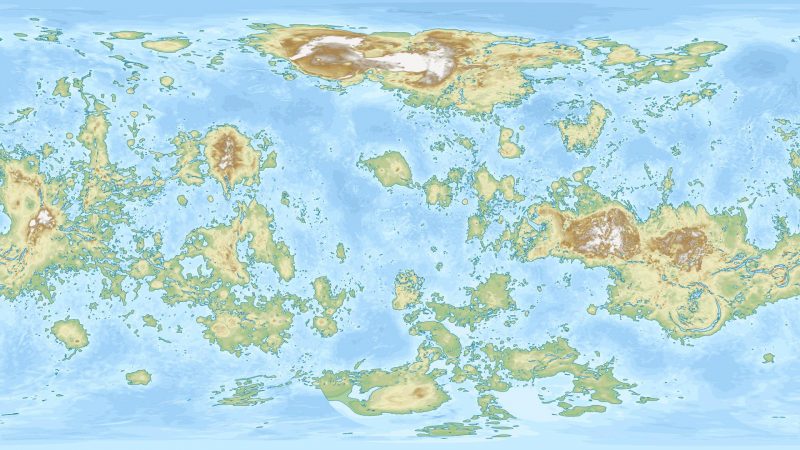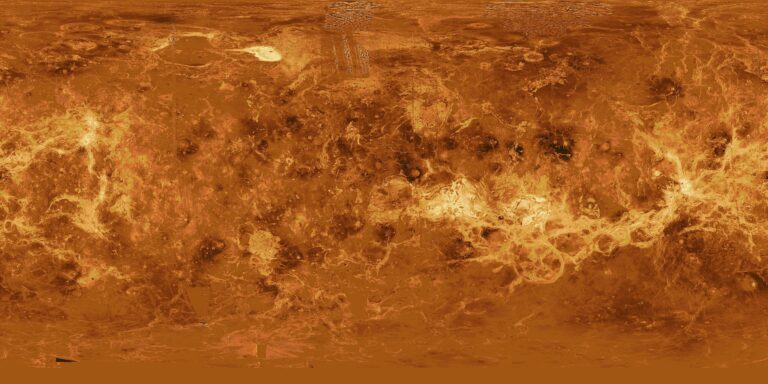A hypothetical map of Venus with the same amount of water as Earth would have a drastically altered appearance.
The climate on Venus is incredibly severe, for enough to melt lead temperatures and enough pressure to flatten most things. Moreover, the clouds of Venus are sulphuric which makes the planet to be completely dry with no surface water current available. However, there are some theories that state that billions of years ago, Venus might have had oceans like the Earth, thus meaning that it could have existed some sort of life.
Some people have even been considering the idea of developing methods of creating the conditions on the planet that existed before Venus lost all its water, and become a water-retaining planet again. However, specific conditions on Venus are hard to bear; they have temperatures as high as those that melt lead and pressure that would crush most buildings. In any case, the clouds on the planet Venus are formed by sulfuric acid, thus, the lack of water on the surface of the planet Venus now.
Nevertheless, based on the climate that is believed to have prevailed approximately several billion years ago, the Venus may have been endowed with oceans similar to those on the Earth suggesting that it could have been habitable. It has also been debated in literature on how future civilizations might one day repair this planetary devastation and turn Venus into a water-rich planet again.

The closeness of this representation raises some questions in the mind. Due to astronomical cloud cover over Venus, the researchers use radar data from space-borne platforms. These are the profiles of the features of Venus which include; mountains, volcanos and plains have been put on map by this technology. Using this data, the founder of Teapot. ai, Alexis Huet, and the world’s second OpenAI worker, Dragonite-2, designed a Venus with terrestrial water content. It reveals fascinating features of them.
If Venus had comparable quantities of water to the Earth, it would have only a single landmass, referred to as Ishtar Terra, situated primarily in the north of the planet. The geologically complex Ishtar Terra encompasses an area the size of Australia and holds the planet’s tallest summit: Maxwell Montes. Secondly, Aphrodite Terra, which is equally a vast region that would look like South American if pulled along the equator would be located near Venus equator.
The map also has other islands, which are also located in the other imaginary global oceans in Venus. Pop-mechanics writer Mike Brown suggested a new vision for Venus – an ocean-covered planet – in the article posted on Inverse on August 29, 2020. “When combined with Paul Byrne, an associate professor of planetary sciences at North Carolina State University, Brown pointed out that the map incorporated real topographical data of Venus along with an assumed ‘sea level’. Aspects such as the portrayal of Venus with oceans similar to that of the Earth make people to wonder about the possibility of such representation.
The map presumably used mean sea level for the Earth in order to simulate the Venus relief after its flood, according to Byrne. But he stated that where the surface of Venus was altered through rainfall, rivers, and more notably, lakes, it would alter within a given period, which was not considered in the map that depicted Venus with no plate tectonics.
Actually, if Venus has water, it can have plate tectonics the same way as the shifting of the plates makes the continents and islands change their places on the Earth. But Byrne noted that Venus can no longer be a water world because of heat which makes any map untrue to the current state of Venus. However, these creative representations raise questions about the character’s past and future.
Byrne was thinking about the fact that Venus might have once had oceans, thus juxtaposing the current state of this planet with some sort of speculation about terraformed Venus. Terraforming Mars is a concept well-known, however, making Venus similar to Earth is more problematic due to the extreme conditions of the surface.

However, there have been ideas of how Venus could be made into a habitable planet, with authors including famous astronomer Carl Sagan suggesting how this could be done from the 1960s onwards. It was Carl Sagan and Linda Salzman Sagan who once proposed that algae could be planted into the clouds of Venus which was later discredited due to the excessive pressure on the planet. Still, the discussion of the concept of transforming planets to make them more suitable to human life never stops, out there citing historical proposals and exists in the scientific community today. The prospect of Venus being turned into a ocean-like planet leads to planning and encourages discussions on the possibility and consequences of such efforts.
On the following day, a short animated video presents a hypothetical slow process of transformation of the entire Venusian surface to resemble a water dominated planet with brief inspiration of potential evolution and changes on other planets. Of course, the first paradox in transforming Venus into a suitable habitat for life is the fact that, having got caught in the cycle of the runaway greenhouse effect, the planet went through the transformation process which brought its temperatures to the levels that can be observed today. Of course, it would not be without its challenges and risks forming this endeavor. It calls for huge energy and sophisticated technology, a goal which to my understanding has remained unachievable to date. However, Paul Byrne notes that there is evidence, facts, and events that can point to pros in making Venus more like earth than in altering Mars.
Byrne also states that Venus is only slightly smaller than the Earth and has twice its gravity, for this reason, she argues that it may be easier to decrease the greenhouse effect on this planet by removing co2, which make up 95% of the atmosphere, than to increase gases in a thin Martian atmosphere to warm it up. If the choice lies between terraforming and the possible planets for it, I would choose Venus over Mars.
However, it must be emphasized: focusing mechanisms to address climate disruption on Earth itself is far more realistic than trying to make any other planetary object even slightly suitable for humans.
This perspective is indeed noteworthy.
Therefore, while the accuracy of Huet’s depiction of Venus on Reddit may be contested by scientists, it stimulates contemplation. It offers a captivating glimpse into a version of Venus previously unexplored, possibly resembling its past state. Furthermore, it presents a tantalizing vision of a potential future world.
For those intrigued by the concept of habitable worlds through terraforming, there’s another intriguing creation shared by Dragonite-2 on the subreddit MapPorn, following shortly after the Venus map. This depiction, also sourced from Alexis Huet’s blog, portrays Earth’s moon transformed into a water-covered entity.
Do not forget to share your opinion with us to provide you with the best posts !




0 Comments